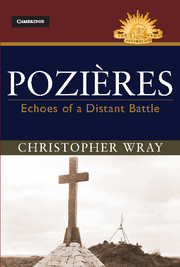Book contents
- Frontmatter
- Contents
- Photographs
- Maps
- Acknowledgements
- Introduction
- Chapter 1 Prelude to Pozières
- Chapter 2 A place of sinister name and tragic happenings
- Chapter 3 A huge and horrible slaughter house
- Chapter 4 Mouquet Farm
- Chapter 5 The dead
- Chapter 6 The maimed, the halt, the lame
- Chapter 7 Those made mad by war
- Chapter 8 The conscription campaign of 1916
- Chapter 9 Writing about Pozières
- Chapter 10 Painting and Pozières
- Chapter 11 Remembering Pozières
- Appendix
- Notes
- Bibliography
- Index
Chapter 10 - Painting and Pozières
Published online by Cambridge University Press: 05 January 2015
- Frontmatter
- Contents
- Photographs
- Maps
- Acknowledgements
- Introduction
- Chapter 1 Prelude to Pozières
- Chapter 2 A place of sinister name and tragic happenings
- Chapter 3 A huge and horrible slaughter house
- Chapter 4 Mouquet Farm
- Chapter 5 The dead
- Chapter 6 The maimed, the halt, the lame
- Chapter 7 Those made mad by war
- Chapter 8 The conscription campaign of 1916
- Chapter 9 Writing about Pozières
- Chapter 10 Painting and Pozières
- Chapter 11 Remembering Pozières
- Appendix
- Notes
- Bibliography
- Index
Summary
On 23 August 1916, a month into the fighting at Pozières, Will Dyson, an Australian artist residing in Britain, wrote to Andrew Fisher, the Australian High Commissioner, suggesting:
It would be of interest to the people of today and in the future to see sketches illustrating the relationship of Australians to the war and interpreting the feelings and character of the Australian troops in France, and the feelings of the French towards them. As this could only be fittingly done by an Australian artist I wish to express my willingness to go to France with this end in view, my work while there to be the property of the Australian Government.
At the time he wrote this letter Dyson was 36 years old and working as cartoonist-in-chief with the Daily Herald, a labour newspaper. Dyson was a socialist with humanist and anti-militarist beliefs and his cartoons reflected his convictions but, like many supporters of the labour movements in Britain, France and Germany, Dyson believed that the war was just and necessary. In 1915 he had published Kultur Cartoons, a book of drawings lampooning German militarism, with a foreword written by H.G. Wells. Although Dyson had lived in Britain since 1909, he retained strong nationalistic feelings towards Australia, and he wanted to depict the Australian soldiers fighting in France, as he made clear in correspondence with Fisher: ‘The precise nature of my work in France would be to interpret in a series of drawings for national preservation, the sentiments and special Australian characteristics of our Army…my drawings would be such studies of Australian soldiers and their neighbours as would be suggested to me by personal contact with our men in their European surroundings.’
- Type
- Chapter
- Information
- PozièresEchoes of a Distant Battle, pp. 187 - 199Publisher: Cambridge University PressPrint publication year: 2015

